
Last year, the Secretary of the Interior David Bernhardt issued an order to allow e-bikes on any non-motorized trails that traditional bikes could access on Bureau of Land Management (BLM), National Park Service (NPS), and Fish and Wildlife Service (FWS) land. This month, that rule was finalized and some of the details have changed.
In the press release, Bernhardt said the initiative was created to make federal land and the outdoors more accessible to everyone.
“Enhancing access to our public lands and expanding recreational opportunities to all Americans is a priority for the Trump Administration,” said U.S. Secretary of the Interior David L. Bernhardt. “The new regulations allow our public land managers to provide e-bike access to bike trails, enhancing the opportunities to utilize our public lands to create life-long memories.”
The final rules for the agencies are all pretty similar and all have have gone with a few key guidelines. The existing federal definition of e-bikes maintains that they are two or three-wheeled cycles with fully operable pedals, and no more than 750 watts (1 horsepower). The Department of Interior (DOI) examined the e-bike class system implemented in states and followed the classifications closely. Time will tell if more brands choose to develop e-tricycles since federal lands have now given them the go ahead.
The agencies also received countless public comments and evaluated concerns, and the DOI says that the the final rules were informed by public feedback from the 60-day comment period. All boiled down, the rules work similarly for each agency that is implementing them under the DOI’s direction and lead to a few key points.
The BLM wants to get more people on e-bikes to more remote places
In their statement, the Bureau of Land Management said “the BLM intends for the final rule to facilitate an increase in e-bike ridership on public lands. The BLM recognizes that the appeal of many BLM-managed roads and trails to cyclists is the opportunity to experience a challenging road or trail that may have inherently limited ridership. Under the final rule, the use of an e-bike could cause increased ridership on these roads or trails.”
Still no wilderness
Wilderness areas are still off-limits to bicycles, motorized or not.
Power limits and classifications
All bikes cannot exceed 750w of power (not more than one horsepower). All allowed e-bikes must have fully operable pedals and the bike must be propelled by pedaling. Class 1 and Class 3 e-bikes are treated the same. Class 1 e-bikes have a pedal-assist up to 20MPH and Class 3 e-bikes have a pedal assist up to 28MPH. E-bikes are being excluded from Off-Road Vehicle classifications, where they had been classified as such.
Accordingly, the rules generally apply to bicycles “whose motor is not being used exclusively to propel the e-bike for an extended period of time on roads and trails upon which mechanized, non-motorized use is allowed.” This gets a little fuzzy when the agencies discuss how this is implemented. The National Park Service states that Class 2 e-bikes are excluded, however, the BLM ruling doesn’t explicitly state that class 2 e-bikes are excluded.
“Under the final rule, authorized officers may allow, through subsequent decision-making Class 1, 2, and/or 3 e-bikes whose motor is not being used exclusively to propel the e-bike for an extended period of time on roads and trails upon which mechanized, non-motorized use is allowed,” says the BLM. This statement contrasts with how Class 2 e-bikes work, being that they can be powered by throttle. It’s safe to assume that since this can play out differently in each and every district, that local land managers will be coming up with their own ways to enforce whether people are using Class 2 e-bike throttles to ride a trail without pedaling “for an extended period of time.”
Local land managers still have power to make other decisions
Superintendents can make exceptions to rules in their districts based on natural, cultural, safety, and other factors. “For example, a superintendent could determine that a trail open to traditional bicycles should not be open to e-bikes, or should be open to class 1 e-bikes only,” says the National Park Service in their statement.
“Every restriction or closure that limits the use of e-bikes must be supported by a written record explaining the basis for such action. The record will explain why e-bikes are managed differently than traditional bicycles if that is the effect of the restriction or closure.”
No NEPAs needed
The agencies under the DOI stated that they didn’t need to conduct a NEPA (National Environmental Policy Act), an environmental analysis, because of categorical exclusions.
“The BLM does not believe that this rule constitutes a major Federal action significantly affecting the quality of the human environment,” said the BLM in their announcement. “A detailed statement under the National Environment Policy Act of 1969 (NEPA) is not required because the rule, as proposed, is categorically excluded from further analysis or documentation under NEPA in accordance with 43 CFR 46.210.” The Tahoe National Forest used the same reasoning when they allowed Class 1 eMTBs on non-motorized trails last year.
Following that decision, the Tahoe National Forest was sued by a group of equestrian advocates and they were forced to retract their decision. The Forest Service as a whole is now accepting public input regarding e-bike access on USFS land, which falls under the Department of Agriculture. It seems likely that the USFS would follow the DOI’s suit and allow e-bike access with similar implementation.
“The NPS is not requiring a system-wide NEPA for the new rule either, and they have stated that NEPAs are best implemented on a park-by-park basis. “In this case, for reasons discussed below, and in light of the fact that the categorical exclusion cited above requires a case-by-case NEPA review at the park level before e-bike use could be authorized at any specific park unit, the NPS does not believe a programmatic approach is appropriate.”
The BLM says that since e-bikes are more similar to traditional bicycles than they are off-road vehicles, that their impact hasn’t prompted studies either. They cited an IMBA study, which said the weight and power of eMTBs aren’t as significant as dirt bikes in terms of soil displacement. E-bikes don’t emit the type of noise that ORVs do, nor do they emit exhaust which could impact air quality,.
The decision still faces challenges
A few months after Bernhardt’s order last year, Public Employees for Environmental Responsibility (PEER) filed a lawsuit against the DOI and the NPS, alleging that the order violated several federal laws, including its own regulations, it evaded environmental reviews, and that Bernhardt and NPS Director P. Daniel Smith held meetings with an “industry-dominated advisory committee called the ‘E-bike Partner & Agency Group’ at Interior Headquarters and through teleconferences.”
PEER says that “the impetus from industry is not surprising given that, as a former industry lobbyist himself, Secretary Bernhardt is known for hearing industry concerns and not public concerns.”
The group is claiming that the e-bike lobbying group held private meetings with Bernhardt and the DOI, which goes against the Federal Advisory Committee Act. FACA requires that committee meetings must be announced in the Federal Register and open to the public.
“The actions of all the Defendants flowed from a violation of FACA.” The parties met at least quarterly during the time the decision was being developed, according to PEER. “The private industry advocacy groups included, but were not limited to, People for Bikes (multiple representatives).”
To be fair, lobbying for increased bicycle access is what groups like People for Bikes are supposed to do. The main dispute then appears to be that the meetings were not made available to the public.
According to Bicycle Retailer and Industry News, the group was disbanded by the NPS after the lawsuit originated. IMBA and the Adventure Cycling Association were also said to have participated in the group.
A few individuals and other organizations joined PEER as co-plaintiffs in the suit, including Wilderness Watch, Marin Conservation League, the Environmental Action Committee of West Marin, and Save Our Seashore. Aside from PEER’s problems with the legality of the decision, the suit also holds a number of subjective grievances and assumptions, some based on anecdotal experiences.
Two of the individual co-plaintiffs, a couple, “have extensive experience with e-bikes on trails in and near New York City and elsewhere. The newly-allowed use of e-bikes now threatens their enjoyment of Acadia, particularly because they are allowed on the renowned old ‘carriage roads,’ extending over 40 miles, which have served primarily as bicycling, hiking, running, and equestrian paths.”
PEER is holding a dispute that the NPS should have been in compliance with NEPA also, and conducted environmental analyses because the “approvals were agency actions with the potential for significant environmental impacts.”
After the recent announcement on the final rules, PEER released a statement that says they won’t back down with regards to their lawsuit. It included emotionally charged, fear-laden language to make its point.
“The Park Service’s undue haste resembles an e-bike whizzing by with an irresponsible teenager on the throttle,” said PEER Senior Counsel Peter Jenkins.





















12 Comments
Oct 16, 2020
eMTN Bikes are the future and just as chairlifts and golf carts did for their sport more ski resorts and golf courses. There will be more and more trails with access and enjoyment for all levels of skill and physical fitness mountain biking.
Oct 19, 2020
Oct 19, 2020
Oct 18, 2020
Oct 16, 2020
Oct 15, 2020
Oct 16, 2020
Oct 15, 2020
Oct 16, 2020
Oct 25, 2020
The verbiage is pretty clear on that, and even Ted Stoll
of STC says it is not ever going to happen if the Dems
control either the Administration or either house of Congress.
Feb 23, 2022
Feb 24, 2022